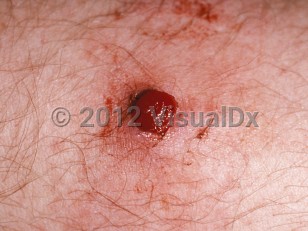Lobular capillary hemangioma in Adult
See also in: External and Internal Eye,Hair and Scalp,Nail and Distal Digit,Oral Mucosal LesionAlerts and Notices
Important News & Links
Synopsis

The majority of patients appear to have no predisposing factors to the development of lobular capillary hemangiomas, which may be cutaneous, mucosal, subcutaneous, or intravascular, the latter two of which have been rarely reported.
Common cutaneous sites are the trunk, head and neck, and extremities, particularly the hands and fingers. Common mucosal sites are gingiva, cheeks, and lips. Since lobular capillary hemangiomas can present in areas of active inflammation or injury, gingivitis and periodontitis are considered risk factors. Lobular capillary hemangiomas are generally painless but ulcerate and bleed easily after minor trauma.
Reports suggest that the lesion is most common in children and young adults, although lobular capillary hemangiomas have been cited in nearly every age group. Mean age of presentation is the second and third decades of life. Cutaneous lobular capillary hemangiomas appear to have a slight predilection for males, whereas mucosal lobular capillary hemangiomas are nearly two times more common in females than in males. Some studies suggest that a hormonal influence on mucosal tissue may account for this difference. Nearly 5% of pregnant individuals develop the lesion on the oral mucosa (granuloma gravidarum) in the second or third trimester. Vulvar lobular capillary hemangiomas have also been reported.
Drugs associated with periungual lobular capillary hemangiomas include isotretinoin, topical retinoids, indinavir, 5-fluorouracil, capecitabine, mitoxantrone, and epidermal growth factor inhibitors (EGFR inhibitors).
Codes
L98.0 – Pyogenic granuloma
SNOMEDCT:
200722003 – Pyogenic granuloma
Look For
Subscription Required
Diagnostic Pearls
Subscription Required
Differential Diagnosis & Pitfalls

Subscription Required
Best Tests
Subscription Required
Management Pearls
Subscription Required
Therapy
Subscription Required
Drug Reaction Data
Subscription Required
References
Subscription Required
Last Updated:08/12/2021
 Patient Information for Lobular capillary hemangioma in Adult
Patient Information for Lobular capillary hemangioma in Adult- Improve treatment compliance
- Reduce after-hours questions
- Increase patient engagement and satisfaction
- Written in clear, easy-to-understand language. No confusing jargon.
- Available in English and Spanish
- Print out or email directly to your patient


